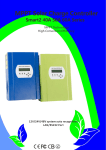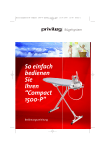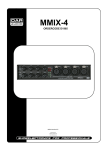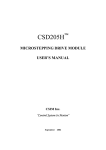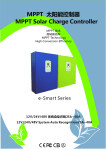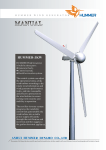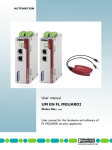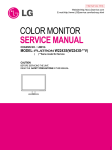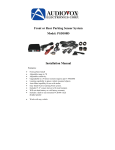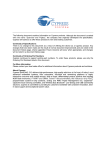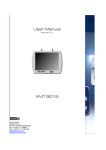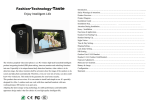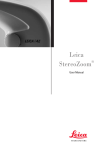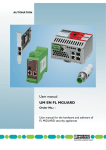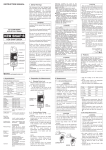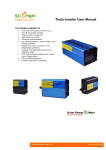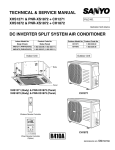Download Shenzhen I-Panda New Energy Technology & Science Co., Ltd.
Transcript
Shenzhen I-Panda New Energy Technology & Science Co., Ltd. I-P-SMART2-40A/50A/60A Manual Contents 1 Notes on this Manual ............................................................................2 2 Safety Instructions................................................................................. 2 3 Unpacking..............................................................................................5 4 Assembly............................................................................................... 6 5 MPPT controller Connection.................................................................7 6 Meaning of LED/LCD and function key............................................10 7 Parameter Setting............................................................................... 12 8 MPPT and PC Connection ............................................................... 13 9 Technical Parameter...........................................................................18 10 Maintenance and Cleaning............................................................ ....20 11 Storage and waste disposal..................................................................21 12 Recovery Processing and Warranty.....................................................21 1. Notes on this Manual This manual describes how to install and service MPPT solar charge controller. 1.1 Validity This manual applies to the whole MPPT solar charge controller models produce by our company: 1.2 Target Group This manual is intended for the installer and the operator. 1.3 All manuals for the device and installed components must be stored in the immediate vicinity of the charge controller and must be accessible at all times. 1.4 Symbols Used The following types of safety messages and general information appear in this document: Warning! WARNING indicates a hazardous situation which, if not avoided, could result in machine stoppage or serious injury. Warning! WARNING indicates a hazardous situation which, if not avoided, could result in machine stoppage or serious injury. Note! In order to operate this device well, please read the operation instruction carefully. 2. Safety Instructions 2.1 General Safety Instructions Warning! Due to high input working voltage, please be cautious, otherwise it is danger to life. • All work on the charge controller must only be carried out by an electrically skilled person. •The appliance is not to be used by children or persons with reduced physical sensory or mental capabilities, or lack of experience and knowledge, unless they have been given supervision or instruction. •Children should be supervised to ensure that they do not play with the appliance. Caution! Be careful for high temperature enclosure parts. • Do not touch the enclosure of the charge controller during operation. Please settle it on the cooling ventilation environment. Caution! Radiation is harmful for health. •Do not stay closer less than 20 cm around the solar charge controller for a long time. 2.2 Explanation of Symbols Below is the explanation for all the symbols shown on the device and label. Symbol Explanation Risk of electric shock Energy stored in capacitors will remain alive for 5 minutes; don’t touch within the period after disconnection Both the sides have circuit lines, disconnect both and don’t operate within 5 minutes after disconnection No self-serviceable parts inside the enclosure, don’t attempt to remove the cover. Only qualified persons are permitted to operate and maintain the equipment. Only insulated tools are permitted to use to reduce risks of hazard to individuals. Beware of hot surface. The solar charge controller can become hot during operation. Avoid contact during operation. And never put any goods onto the equipment under load. ● Symbols on the Type Label Symbol Explanation CE FCC CB ROHS mark; The device complies with the requirements of the applicable CE FCC CB ROHS guidelines. ●Important Safety Instructions When using the product, please do remember the below information to avoid the fire, lightning or other personal injury: Warning! Ensure input DC voltage no more than Max. DC voltage .Over voltage may cause permanent damage to solar charge controller or other losses, which will not be included in warranty! This chapter contains important safety and operating instructions. Read and keep this operation guide for future reference. Warning! Authorized service personnel must disconnect both DC and battery bank power from the solar charge controller before attempting any maintenance or cleaning or working on any circuits connected to the solar charge controller. ● Before using the solar charge controller, please read all instructions and cautionary markings on the solar charge controller, and all corresponding sections of this guide. ● Please use components and parts recommended or sold by I-Panda New Energy. Otherwise may result in a risk of fire, electric shock, or injury to person. ● To avoid a risk of fire and electric shock, make sure that existing wiring is in good condition and that wire is not undersized. Do not operate the solar charge controller with damaged or substandard wiring. ● Do not disassemble the solar charge controller. It contains no user-serviceable parts. See Warranty for instructions on obtaining service. Attempting to repair the solar charge controller by yourself may result in a risk of electric shock or fire and will make your warranty invalid. ● To reduce the risk of electric shock, authorized service personnel must use insulating tool to operate the device. ● Keep away from flammable, explosive materials to avoid fire disaster. ● The installation place should be away from humid or corrosive substance. ● To reduce the chance of short-circuits, authorized service personnel must use insulated tools when installing or working with this equipment. 3. Unpacking 3.1 Device parts checking: E C A D G F H Object A B C D E Quantity 1 unit 2 pc 4 set 2 pc 1 pc F G 1 pc Description Charge controller Gallow pulley screw joint 232 turn to RJ45 communication cable User manual 1 pc Temperature sensing wire H 2 pc Fuse wire If there is any part missing, please contact your dealer. 3.2 Check for Transport Damage Check the charge controller for visible external damage, such as cracks in the enclosure. Contact your dealer if you find any damage. 3.3 Identifying the Charge Controller You can identify the charge controller by the type label. The type label is in the enclosure. 4. Assembly 4.1 Operator:technical personnel; 4.2 Selecting the Mounting Location Danger: Danger to life due to fire or explosion. The charge controller enclosure can become hot during operation. • Do not mount the charge controller on flammable construction material. • Do not mount the charge controller near highly flammable materials. • Do not mount the charge controller in potentially explosive areas. • Do not expose the charge controller to direct sunlight to avoid power loss due to overheating. Caution: Danger of burn injuries due to hot enclosure parts. • Mount the charge controller in such a way that it cannot be touched inadvertently during operation. 4.2.1 Dimensions L * W * H:270mm*150mm*88mm 4.2.2 Net Weight Weight:3kg 4.2.3 Ambient Conditions • The mounting location and method must be suitable for the weight and dimensions. • Mount on a solid surface. • The mounting location must be accessible at all times. • The charge controller must be easy to remove from the mounting location at any time. • The ambient temperature should be between -20 °C and +60 °C to guarantee optimal operation. • Do not expose the charge controller to direct sunlight to avoid power losses due to overheating. 4.2.4 Safety Clearance Observe the following safety clearance to wall, other devices or objects to ensure sufficient heat dissipation. Direction Sides Top Bottom Safety clearance 20cm 30cm 20cm 5. MPPT controller Connection 5.1 Safety Danger! Danger to life due to high voltage in the solar charge controller. • Disconnect the PV array using a disconnection unit and secure it against accidental reactivation. • Disconnect the circuit breaker and ensure that it cannot be reconnected. • Ensure that no voltage is present in the system. Warning: Risk of injury due to electric shock。 If all cables with different voltages are routed in parallel, damaged cable insulations may lead to a short circuit. • Route all cables separately. Warning: Over voltage can destroy the system. • Use an external over voltage protector in areas with an increased risk of thunderstorm and lightning. 5.2 Connections of the PV power system 5.2.1 PV String Solar charge controller device can be connected in series into 1-strings PV modules. Please select PV modules with excellent function and reliable quality. Open-circuit voltage of module arrays connected in series should be less than Max. DC input Voltage (150V); operating voltage should be conformed to MPPT voltage range. Please use PV cable to connect modules to device. From junction box to device, voltage drop is about 1-2%. So we suggest the solar charge controller install near PV module, in order to save wire and reduce DC loss. Note: Please don’t connect the PV panel positive or negative to ground. Warning: PV module voltage is very high which belongs to dangerous voltage range, please comply with electric safety rules when connecting. 5.2.2 The voltage of battery system and types 1) This controller could charge for DC 12 V/ 24 V/48V battery system . It would automatic recognition the voltage system : 2) The controller had already been set to charge 4 types battery as following form . If have other need , the charge parameter also could be reset through machine and solar eagle . The details please check the illustrate . The charging voltage of battery type Bulk Voltage Battery Type Vented Sealed Gel NiCd Floating Voltage 12V 24V 48V 12V 24V 48V 14.2V 28.6V 57.2V 13.2V 26.4V 52.80V 14.2V 28.6V 57.2V 13.4V 26.8V 53.60V 14.2V 28.6V 57.2V 13.7V 27.40V 54.80V 14.2V 28.6V 57.2V 14.0V 28.0V 56.0V user-defined(Set by the microcomputer software) In the case battery type is not set , use the default battery type (Gel battery). Other 5.2.3 The voltage of DC load system and Max current : This controller had added DC load output function , the output voltage range based on the type of battery bank system . Like the battery bank voltage is 48V , DC output voltage range will be the range of 48V battery bank working voltage . 1) How to turn DC output turn on/off ? Please find the DC output control through MPPT or Solar Eagle software . It have 6 way to control it : ON Mode / OFF Mode / Time Control Mode /PV Volt Ctrl / PV&Time Ctrl : Details please check the Setting ; 2) How to set the low voltage protection of DC output ? This controller have low voltage protection ,the magnitude of low voltage protection Could be set based on customer’s need . Factory settings is 10.5 V for 1 battery .If the DC output is under the State of providing power for load ,then when the voltage under the magnitude of low voltage protection , the DC output will stop provide power for load . When the voltage of battery is recover to 0.5V bigger the magnitude of low voltage protection ,it will restart . For 48V system , if the DC output under on mode , then when the battery bank will stop provide power under 42V , it will restart when the voltage recover to 42.5 V . 3) Max DC output current Then Max DC output current is 50A , if the output current out the rated current ,the built-in fuse will be burn . We provide 2 fuse as back up ; 5.2.4 Specification for cable and micro-breaker Model Cable (Cu) Micro-Breaker I-P-Smart240A ≥4mm 63 A I-P-Smart250A ≥4mm 63 A I-P-Smart260A ≥4mm 63A Micro-breaker should be installed between DC output and battery. Kindly check the following picture ( we do not provide built-out breaker ): 5.2.5 MPPT controller work step Cation : Please follow the steps ,or the machine will be easy to broke . Please make sure the MPPT had already been connected in right way . Step 1 : Open the breaker that connect with battery , make sure the MPPT controller had been connect with with the battery .( When all this done ,the LED and LCD will show some information ) Step 2 :Turn on the breaker that connect with PV module , if the PV module voltage is in the charging range , then machine will start to work . Step 3 : If need DC load control , please set the DC output control mode , then turn on the DC output breaker . 5.2.6 The step of turn off machine Cation : Please follow the steps ,or the machine will be easy to broke . Step 1 : Turn off the PV input breaker ,make sure PV and controller disconnect . Step 2: Turn off the battery breaker , the machine will be complete off . Warning:When the controller is charging for battery , please do not turn off the breaker with battery before PV input have not turn off . Or the machine will have unrecoverable fault and this will not in the warranty . 6、Meaning of LED/LCD and function key 6.1 Panel Description Meaning of LED and function key ALARM (Red) ----- Alarm Light ( Red , when controller in fault state this light will on . ) CHANGE(Blue) ----- Charging Light ( Blue ,when controller start to charge power ,this light will on .) LOAD(Green)------- Load Light (Green , when the DC load turn on ,this load will on ) UP ----------- UP Function Key (For check or page up and numerical increase ) DOWN ------- DOWN Function Key ( For check or page up and numerical reduction ) ENTER ------------------ ENTER key ( For enter in ) ESC ------------------- ESC Key ( For exit and save data ) 6.2 Charge Mode This controller have 3 mode :Constant charging stage ( CC Mode ) , Constant voltage charging stage ( CV Mode ) , Floating charge Stage ( FC Mode ) : In CC Mode ,the blue light will flash for every second . In CV Mode ,the blue light will flash for every 3 second . In CF Mode ,the light will keep on . ( Note : Charging Mode also could check in LCD and solar eagle .) Menu No. 1 2 3 Menu Type Menu Description Work Status Setting Information For check the charging state Parameter set For check the parameter 6.3.1 The information of LCD display in different menu . SMART 2 MPPT LCD INFORMATION Note If is charging ,it will have information Charing Mode Time If connect temperature sensing wire ,then will show temperature Chg Cur(Charge current) Chg Model(Charging Mode) Time Bat Temp(The real time temperature) Work Status Buck Temp(The main real time temperature) PV Volt(Solar panel voltage) Chg Power(Real time charge power ) Bat Volt(Battery real time voltage) Vented PV input voltage Charging power Show battery voltage , if is charging , it will show charging voltage . Will show fault mode under fault state Battery type set Bat Type Sel Setting User Bat Set Gel Nicd Sealed User Def Bulk Volt Set Special battery ,just need to set Main charging voltage and float charging voltage .Please based on one battery . Float Max Chg Cur Set Setting Date Set Time Gate Address Set Port Set IP Address Set Load Control Time Control Load Off Bat Volt On/Off Mode PV Volt Ctrl PV & Time Ctrl Information Bat Chg SYS Total power Firmware Ver. Machine ID Bat Type IP Address Port Time Load Ctrl Could set any data under rated number Date Set Time Set Gate Address Set Port Set IP Address Set Set the double time to control the DC load output on / off Set the low voltage protection of battery . ( Based on one battery ) Keep on / off state Could set the PV voltage to control DC load output turn on/off Could set the PV voltage and time to control DC load output turn on/off System Voltage Total energy from this machine Firmware Ver. Machine ID Battery Type display IP Address Port Number Last time load control mode 7、 Parameter Setting When controller connect with battery and it is in on state ,the controller will show the information of Work Status . 7.1 Could be set parameter of MPPT Please check the details under Setting Interface 7.2 The steps of setting Press ESC into main menu ----> Press down to change the page to setting---->Press ENTER to get in ---->to press down to chose the information need be set .For example : Press ESC into main menu ----> Press down to change the page to setting---->Press ENTER to get in ---->Press DOWN to change to load control---->Press ENTER to get in ---->Press DOWN to On/Off Mode---->Press ENTER to get in ----> Press UP or down to Load On mode---->Press ESC to save and exit . 8、MPPT and PC Connection 8.1 Solar Eagle introduction Our company had develop PC operational software , customer check all information of solar system and change some parameters , if have our company accredit, even could change some original parameters . The solar eagle are as following picture : overview: Get into main interface as following Com Setting ( Com):Get into set the connection of Solar Eagle and PC . Setting:Get into battery type set and load control set interface Data:MPPT working status Event Log :MPPT working status per day Login :Some parameters set need administrator’s pass word . 8.2 Then connection of MPPT and Solar Eagle . Could connect trough RS 232 ( COM ) or ( TCP/IP) 8.2.1 Connect through RS232 ( COM ) 1)Customer’s PC have RS232 connector , check the following picture Step 1 : Please install Solar Eagle ,details please kindly check install steps . Step 2 : Installed and connected controller ,and make sure controller under on state (after controller connect battery ,the controller will automatic start ) Step 3:Connect PC and controller with RS232 ,make sure they had been connect ,PC will notice com ,at this time the PC will chose COM1 : Step 4:Open Solar Eagle ( WIN 7 administrator ) ,then press automatic connect : , WIN 8 system ,please open as to chose COM communication and enter ,it will Step 5 : After all these steps ,the information could be check on Solar Eagle .If need to set special parameters ,please ask our company to accredit . 2) Customer do not have PC connector . If customer do not have RS232 connector , then customer need to prepare a USB to RS232 connector like the following picture : Step 1: Please install USB to RS232 driver software and make sure it had been connect with RS232 . The other step is same as above . 8.2.2 Connect through LAN ( TCP/IP ) 1)Connect through RJ45 ,like the following picture Step 1 : Please install Solar Eagle ,details please kindly check install steps . Step 2 : Installed and connected controller ,and make sure controller under on state (after controller connect battery ,the controller will automatic start ) Step 3: Connect PC and controller through RJ45 . Step 4: First way :Based on PC GATED ADDRESS and IP ADDRESS to set the controller’s PC GATED ADDRESS and IP ADDRESS . But please note the last number of IP address should keep different .Like : PC’s PC GATED ADDRESS is 192.168.1.1 ,IP ADDRESS is 192.168.1.10 , then set of controller is GATED ADDRESS is 192.168.1.1 ,IP ADDRESS is 192.168.1.8 : Make sure controller and PC in the same LAN . Second way :Based on PC GATED ADDRESS and IP ADDRESS to set the controller’s PC GATED ADDRESS and IP ADDRESS . But please note the last number of IP address should keep different .Like : Controller’s GATED ADDRESS is 192.168.1.1 ,IP ADDRESS is 192.168.1.10 , then set of PC’s GATED ADDRESS is 192.168.1.1 ,IP ADDRESS is 192.168.1.8 : Make sure controller and PC in the same LAN . Step 5: Open Solar Eagle ( WIN 7 ,WIN 8 system ,please open as administrator ) ,then press to chose TCP/IP communication and fill IP address and port number ,enter ; It will automatic connect in 10s : If could not connect , please make sure controller and PC in the same LAN and restart controller . 1)Connect through router as following picture ; Step 1 : Please install Solar Eagle ,details please kindly check install steps . Step 2 : Installed and connected controller ,and make sure controller under on state (after controller connect battery ,the controller will automatic start ) Step 3: Connect controller and router through RJ45 .Then add PC into LAN. Step4: Set controller and PC’s GARE ADRESS based on router’s GATE ADRESS .Keep them in the same LAN . Like : router’s GATE ADRESS is 192.168.1.1 ,then controller and PC’s GARE ADRESS should be 192.168.1.1 . Step 5 : IP ADRESS setting Set the controller and PC’s IP address ,based on GATE ADDRESS to set IP ADDRESS , the last number should be different :Like IP’s GATE ADRESS is 192.168.1.1 ,PC’s IP ADDRESS should be 192.168.1.10 ,the controller’s IP ADDRESS should be 192.168.1.5; Step 6: Open Solar Eagle ( WIN 7 ,WIN 8 system ,please open as administrator ) ,then press to chose TCP/IP communication and fill IP address and port number ,enter ; It will automatic connect in 10s : If could not connect , please make sure controller and PC in the same LAN and restart controller . 8.2.3 Usage of Solar Eagle When Solar Eagle have been connect ,customer could check and change some parameters; If have some special parameters need to be change , please purchase pass from our company : Step 1;Contact us to have password Step 2:Login Step 3:Change parameters 9、Parameters Model:I-P-SMART2-40A/50A/60A -series 40A 50A 60A Charge Mode Maximum Power Point Tracking Method 3 stages: fast charge(MPPT),constant voltage, floating charge System Type DC12V/24V/48V Automatic recognition 12V system DC9V~DC15V 24V system DC18V~DC30V 48Vsystem DC36V~DC60V Soft Start Time 12V/24V/48Vsyste m ≤10S Dynamic Response Recovery Time 12V/24V/48Vsyste m 500us Conversion Efficiency 12V/24V/48Vsyste m ≥96.5%,≤99% System Voltage PV Modules Utilization Rate 12V/24V/48Vsyste m ≥99% Input Characteristics 12V system DC18V~DC150V 24V system DC34~DC150V 48V system DC65~DC150V 12V system DC16V 24V system DC30V 48V system DC60V Low Voltage Input 12V system DC22V Recovery Point 24V system DC34V 48V system DC65V Max DC Voltage 12V/24V/48V system DC160V Input Overvoltage Protection Point 12V/24V/48V system DC150 Input Overvoltage Recovery Point 12V/24V/48V system DC145V MPPT Working Voltage and Range Low Voltage Input Protection Point Max. PV Power 12V system 570W 700W 900W 24V system 1130W 1400W 1700W 48V system 2270W 2800W 3400W Output Characteristics Selectable Battery Types (Default type is GEL battery) 12V/24V/48Vsyste m Constant Voltage 12V/24V/48V system Floating Charge Voltage 12V/24V/48V system Over Charge Protection Voltage Sealed lead acid, vented, Gel, NiCd battery (Other types of the batteries also can be defined) Please check the charge voltage according to the battery type form. 12V system 14.6V 24V system 29.2V 48V system 58.4V Rated Output Current 12V/24V/48V system 40A 50A 60A Current-limiting Protection 12V/24V/48V system 44A 55A 66A Rate charge current 12V/24V/48V System 40A 50A 60A Temperature Factor 12V/24V/48V system ±0.02%/℃ Temperature Compensation 12V/24V/48V system 14.2V-(The highest temperature-25℃)*0.3 Output 12V/24V/48V 200mV Ripples(peak) system Output Voltage Stability Precision 12V/24V/48V system ≤±1.5% Charge voltage Peak-Peak Ripple 12V/24V/48V System 200mV Charger voltage accuracy 12V/24V/48V System ≤±1.5% Discharge characteristic Setting Control Controller or LAN Max discharge current 12V/24V/48V System 40A Discharge protection 12V/24V/48V System fuse 30A*2 Double-time control 12V/24V/48V System ON / OFF mode 12V/24V/48V System ON / OFF PV voltage control 12V/24V/48V System PV voltage on,PV voltage off PV voltage / time delay control 12V/24V/48V System PV voltage on,time delay off Discharge voltage protection 12V/24V/48V System Output off when it under setting voltage; Factory set is 10.5 .( Note : set based on 1 battery ) On in morning ,off in morning / On in night ,off in night Communication Features RS232 Communication 12V/24V/48V System Chose COM communication LAN Communication 12V/24V/48V System Set IP and Gate address for controller and solar eagle ;Then chose TCP communication Protection Input Low Voltage Protection Check the input characteristics Input Overvoltage Protection Check the input characteristics Input Polarity Reversal Protection yes Output Overvoltage Protection Check the output characteristics Output Polarity Reversal Protection yes Short-circuit Protection Recover after eliminating the Short-circuit fault, no problem for long term Short-circuit Temperature Protection 95℃ Temperature protection Above 85℃,decrease the output power, decrease 3A per degree. Other Parameters Noise ≤40dB Thermal methods Forced air cooling, fan speed rate regulated by temperature, when inner temperature is too low, fan ran slowly or stop; when controller stop working, fan also stop ran. Components World brand raw materials. Compliance with EU standards. All rated temperature of electrolytic capacitors not less than 105℃ Smell No peculiar smell and toxic substances. Environment Protection Meet the 2002/95/EC,no cadmium hydride and fluoride Physical Measurement DxWxH (mm) 270*185*90 N.G(kg) 3 G.N(kg) 3.6 Color Blue/Green (optional) Safety CE, RoHS, PSE,FCC EMC EN61000 Type of Mechanical Protection IP21 Environment Humidity 0~90%RH ( no condense) Altitude 0~3000m Operating Temperature -20℃ ~ +40℃ Storage Temperature -40℃ ~ +75℃ Atmospheric Pressure 70~106kPa 10. Maintenance and Cleaning 10.1 Replacing the Thermal Fuses Using incorrect thermal fuses may irreparably damage the solar charge controller. • Only use the thermal fuses included in the scope of delivery 1. Open the solar charge controller as described in section "Opening the solar charge controller" 2. Remove the broken thermal fuses from the sockets (A and B). 3. Insert new thermal fuses (included in the scope of delivery). 4. Close the solar charge controller as described in section "Closing the solar charge controller". Location of Thermal Fuses 10.2 Cleaning the Cooling Fin Clean the Fan air vents and internal cooling fin regularly by using the dry or small wet cloth to wipe. Attention: • Liquid detergent or corrosive solvent cleaning are forbidden. • Liquid is not allowed to down in the device. • Make the air vent open. •Carefully remove dirt with a suitable soft brush. 11. Storage and waste disposal. 10.1 Store the charge controller in a dry place with ambient temperatures between -40 °C and +75 °C. 10.2 Disposal Dispose of the solar charge controller at the end of its service life in accordance with the disposal regulations for electronic waste which apply at the installation site at that time. 12. Recovery Processing and Warranty 12.1 Recovery Processing When the controller abnormal, please check the following question and contact the customer service representative. 11.1.1 Controller failure mode: Please check the fault tips in the failure mode, and then proceed to the appropriate troubleshooting; 11.1.2 When the controller does not start properly: 1. Check the controller external solar panels with the correct polarity. 2. Check Battery Connection; 3. Check Battery; 4. Check circuit breaker; 5. Check internal fuse; If the problem persists , please contact the customer service; Please offer the following information : Equipment information: Model, Order No., serial-number(Stickers on the rear plate); Detailed description of the problem (Type of system, occasionally/frequent problems, indicator light, data display, and so on ). 12.2 Warranty Within the warranty period, it is free to repair for the non-human fault. Otherwise, should charge the cost of repairs. 12.3 Guarantee Card User name: Address: Telephone Number: Email: Date of Purchase: Date of Installation: Installer Contact Information: Solar Charge Controller Serial Number: Battery Voltage: PV Module Type and Manufacturer: Array Wattage: Country: Pose Code: Vendor: Installer: PV Voltage: Notes:

























